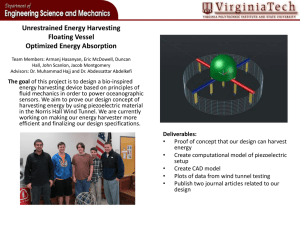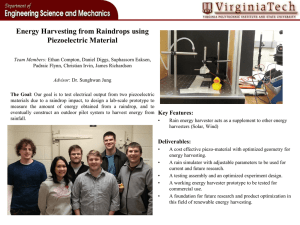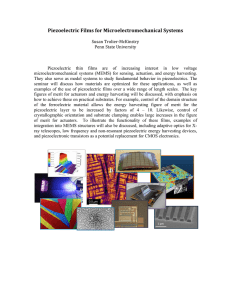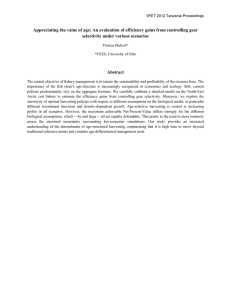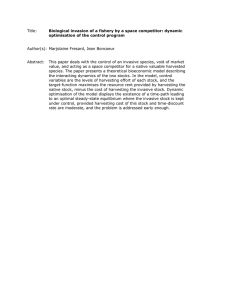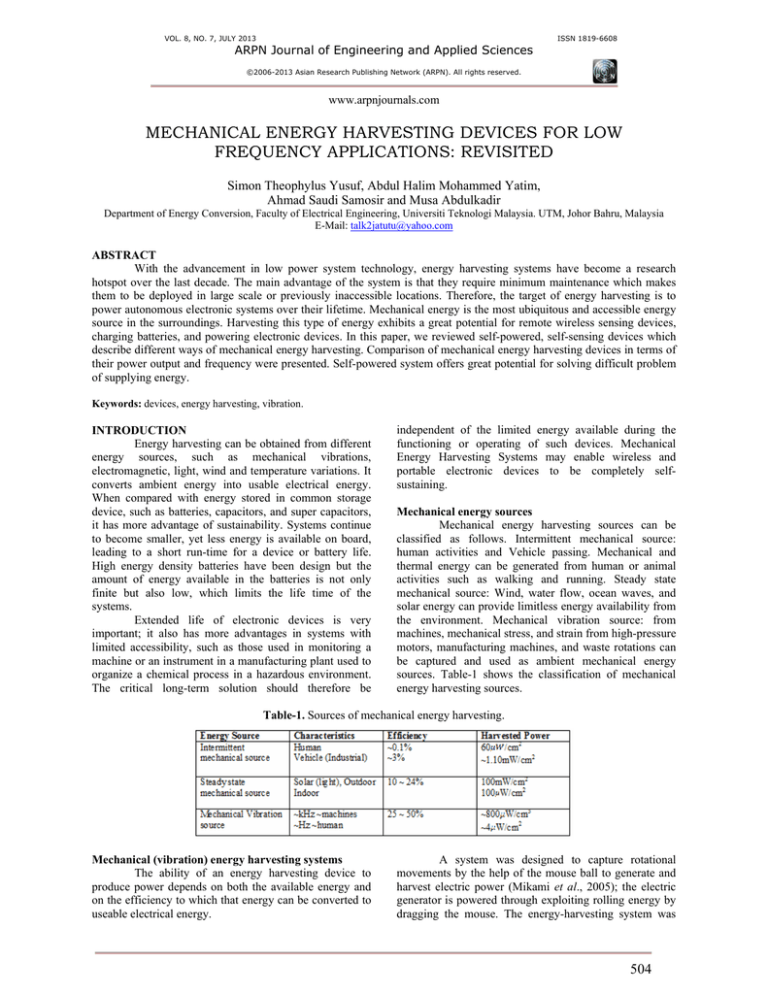
VOL. 8, NO. 7, JULY 2013
ISSN 1819-6608
ARPN Journal of Engineering and Applied Sciences
©2006-2013 Asian Research Publishing Network (ARPN). All rights reserved.
www.arpnjournals.com
MECHANICAL ENERGY HARVESTING DEVICES FOR LOW
FREQUENCY APPLICATIONS: REVISITED
Simon Theophylus Yusuf, Abdul Halim Mohammed Yatim,
Ahmad Saudi Samosir and Musa Abdulkadir
Department of Energy Conversion, Faculty of Electrical Engineering, Universiti Teknologi Malaysia. UTM, Johor Bahru, Malaysia
E-Mail: talk2jatutu@yahoo.com
ABSTRACT
With the advancement in low power system technology, energy harvesting systems have become a research
hotspot over the last decade. The main advantage of the system is that they require minimum maintenance which makes
them to be deployed in large scale or previously inaccessible locations. Therefore, the target of energy harvesting is to
power autonomous electronic systems over their lifetime. Mechanical energy is the most ubiquitous and accessible energy
source in the surroundings. Harvesting this type of energy exhibits a great potential for remote wireless sensing devices,
charging batteries, and powering electronic devices. In this paper, we reviewed self-powered, self-sensing devices which
describe different ways of mechanical energy harvesting. Comparison of mechanical energy harvesting devices in terms of
their power output and frequency were presented. Self-powered system offers great potential for solving difficult problem
of supplying energy.
Keywords: devices, energy harvesting, vibration.
INTRODUCTION
Energy harvesting can be obtained from different
energy sources, such as mechanical vibrations,
electromagnetic, light, wind and temperature variations. It
converts ambient energy into usable electrical energy.
When compared with energy stored in common storage
device, such as batteries, capacitors, and super capacitors,
it has more advantage of sustainability. Systems continue
to become smaller, yet less energy is available on board,
leading to a short run-time for a device or battery life.
High energy density batteries have been design but the
amount of energy available in the batteries is not only
finite but also low, which limits the life time of the
systems.
Extended life of electronic devices is very
important; it also has more advantages in systems with
limited accessibility, such as those used in monitoring a
machine or an instrument in a manufacturing plant used to
organize a chemical process in a hazardous environment.
The critical long-term solution should therefore be
independent of the limited energy available during the
functioning or operating of such devices. Mechanical
Energy Harvesting Systems may enable wireless and
portable electronic devices to be completely selfsustaining.
Mechanical energy sources
Mechanical energy harvesting sources can be
classified as follows. Intermittent mechanical source:
human activities and Vehicle passing. Mechanical and
thermal energy can be generated from human or animal
activities such as walking and running. Steady state
mechanical source: Wind, water flow, ocean waves, and
solar energy can provide limitless energy availability from
the environment. Mechanical vibration source: from
machines, mechanical stress, and strain from high-pressure
motors, manufacturing machines, and waste rotations can
be captured and used as ambient mechanical energy
sources. Table-1 shows the classification of mechanical
energy harvesting sources.
Table-1. Sources of mechanical energy harvesting.
Mechanical (vibration) energy harvesting systems
The ability of an energy harvesting device to
produce power depends on both the available energy and
on the efficiency to which that energy can be converted to
useable electrical energy.
A system was designed to capture rotational
movements by the help of the mouse ball to generate and
harvest electric power (Mikami et al., 2005); the electric
generator is powered through exploiting rolling energy by
dragging the mouse. The energy-harvesting system was
504
VOL. 8, NO. 7, JULY 2013
ISSN 1819-6608
ARPN Journal of Engineering and Applied Sciences
©2006-2013 Asian Research Publishing Network (ARPN). All rights reserved.
www.arpnjournals.com
intended to power the electronic system of a mouse
device, such as the ultra low power RF transmitter and
microcontroller. The total energy captured using an
energy-harvesting system was higher than 3mW, which
was enough for the wireless mouse operations in a
transmit range of one meter.
A novel wireless sensor system that harvests
vibrations of the bridge created by passing traffic which is
converted into usable electrical energy by means of a
linear electromagnetic generator, allows harvesting of up
to 12.5mW of power in the resonant mode with the
frequency of excitation at 3.1Hz (Edward et al., 2009).
Because of the high level tight integration of the power
generator and a smart algorithm for energy conversion that
switches between the low-power mode and the impedance
matching mode, the device performance was good and
should be encouraged for improvement. Busy roads,
railway track beds and runways the airport, has the
potential to convert into electrical energy Figure-1. As the
car moves along the road, the vertical displacement takes
place under the tires, which transmit the weight of the
vehicle on the road and the reaction will result to heat.
With piezoelectric generators embedded in road materials,
part of the energy expended on deformation of the road
can be converted into electrical energy (piezo-electric
effect).
source is needed in order to place an initial charge on the
capacitor plates.
Figure-2. Three possible topologies for micro electrostatic
converters (Sterken et al., 2003).
Dynamic models with electromechanical
couplings have been established (Yu-Jen et al., 2012),
with output power of approximately 300-550mWatt at
about 200-500rpm. The magnets were integrated in a
novel circular Halbach array and coils into the design to
augment the magnetic strength on one side of the array
where the coils are placed. Because the magnetic flux
density for the circular Halbach array disk is larger than
that of the multipolar magnetic disk, it utilizes the
presence of the nonlinearity model and the well-weighted
swing disk to maximize the power output and the
frequency bandwidth for a wheel rotating at any speed.
The Circular Halbach array magnetic disk and multipolar
magnetic disk are shown in Figure-3.
Figure-1. A novel battery-less wireless sensor embedded
in the road.
Another mechanical energy harvesting base on
electrostatic micro generator was proposed by (Sterken et
al., 2003). In this system, a micro electrostatic converter
Figure-2, consisted of a vibration sensitive variable
capacitor was polarized by an electret. A general multi
domain model was built and analyzed in the same study,
and it showed that power generation capabilities up to
50µw for 0.1cm2 surface areas were attainable and used.
The output power is very low to be use for powering
portable devices. If the charge on the capacitor is
maintained constant while the capacitance decreases the
voltage will increase. If the voltage on the capacitor is
maintained constant while the capacitance decreases, the
charge will decrease. The mechanical energy converted
into electrical energy is greater if the voltage across the
capacitor is constrained than if the charge across the
capacitor is constrained. However, the initial voltage
source needed has a smaller value if the charge across the
capacitor is constrained. A way to increase the electrical
energy for the charge constrained method is add a
capacitor in parallel with the MEMS capacitor. The main
disadvantage of this method is that a separated voltage
Figure-3. Schematic diagrams of (a) Circular Halbach
array magnetic disk, (b) multipolar magnetic disk
(Yu-Jen et al., 2012).
Researchers
have
developed
various
electromagnetic vibration energy harvesters ranging from
micro electro mechanical (MEM) devices (Shearwood and
Yates, 1997) to larger system (Glynne-Jones et al., 2004).
(Roundy et al., 2004) Develop a system that produced
energy from vibrations which is based on the movement of
a spring-mounted mass relative to its support frame.
Mechanical acceleration is produced by vibrations that, in
turn, cause the mass component to move and oscillate.
This relative displacement causes opposing frictional and
damping forces to be applied against the mass, thereby
reducing and eventually extinguishing the oscillations. The
damping force energy can be converted into electrical
energy via an electric field (electrostatic), magnetic field
(electromagnetic), or strain on a piezoelectric material.
In electromagnetic energy harvesters, permanent
magnets are normally used to produce strong magnetic
field and coils are used as the conductor. Either the
505
VOL. 8, NO. 7, JULY 2013
ISSN 1819-6608
ARPN Journal of Engineering and Applied Sciences
©2006-2013 Asian Research Publishing Network (ARPN). All rights reserved.
www.arpnjournals.com
permanent magnet or the coil is fixed to the frame while
the other is attached to the inertial mass. In most cases, the
coil is fixed while the magnet is mobile as the coil is
fragile compared to the magnet and static coil can increase
lifetime of the device. Ambient vibration results in the
relative displacement between the magnet and the coil,
which generates electrical energy. According to Faraday’s
Law, the induced voltage, also known as electromotive
force (e.m.f), is proportional to the strength of the
magnetic field, the velocity of the relative motion and the
number of turns of the coil. Generally, there are two types
of magnetic induction system as shown in Figure-4.
Electromagnetic device (magnet/coil) configurations have
been considered in research and a limited number of
commercial units were developed (www.perpetuum.co.uk,
2008) the device is capable of converting up to 30% of the
total energy supplied into useful electrical energy.
Figure-4. Movement of magnet: (a) across and (b) through
a coil.
Demonstration
of
a
vibration
driven
electromagnetic energy harvester for a self-powered
system was presented by (Byung et al., 2012). The energy
harvester consists of NdFeB permanent magnets, a planar
spring, and a cylindrical-type copper coil. The released
device generated a maximum output power of 1.52mW
against a load resistance of 5.46 k at a resonance
frequency of 16Hz. Compared to the previously design
reported low frequency driven energy harvesters, this
prototype can generate higher output power at lower
frequency. A self-powered device driven by nanogenerator
(Xiaohong et al., 2012) was designed. Device showed
desirable output of 140W and the sputtering time was 30
minutes. The sputtering target was tungsten oxide and the
purity 99.99%. The thickness of the film as measured by a
profilometer was about 250 nm. The device can be use not
only for monochrome displays or electronic billboards but
also for portable electronic devices.
A generator consisting of a permanent magnet
core mounted at the tip of a planar steel beam. As the
device is shaken, the resonant beam oscillates back and
forth. The results show an output power of 0.53mW with
an input vibration of amplitude 25µm, and frequency
322Hz. excluding the clamp at the base of the beam and
the coil mounting, the device requires a volume of
0.24c
. It is interesting to note that, regarding the small
size of this device, micromachining techniques were not
used in its construction (El-hami et al., 2000). An
important point to be considered in practical energy
harvesting systems is the possibility of having a fully self
powered circuitry. In other words, the energy harvested by
the transducer and stored in a capacitor, in a super
capacitor or in a rechargeable battery should also supply
the active circuitry. (Enrico et al., 2011) design an active
electronic interface for an energy harvesting system
including a vibration based electromagnetic transducer.
The transducer provides a peak voltage of 3.25V when
operated close to its mechanical resonance frequency
about 10.4 Hz. The circuit is a full-cycle inductive step-up
ac/dc converter able to process every voltage pulse coming
from the transducer. From the result it makes the system
fully autonomous.
A micro machined generator that comprises a
permanent magnet mounted on a laser-micro device spring
structure next to a coil, occupying around 1cm3 generates
10µW of power at 2V DC with an input excitation
frequency of 64Hz and amplitude of 100µm (Li et al.,
2000). With the generated high frequency of the machine,
it can be used for devices that require very low power and
high frequency. A new micro electromechanical systems
(MEMS) self-powered sensor and RF transmission
platform for wireless sensor network (WSN) nodes has
been design to operate at energy levels. This device drive a
passive kick-and-resonate transmitter architecture as an
alternative to a standard power hungry transmitter, this
platform eliminates the need for both secondary energy
storage and power conditioning circuits (Cairan et al.,
2011). It may be highly impractical to regularly replace or
recharge embedded or implanted batteries, especially if
there are many nodes forming a network. Much research
effort in recent years has been devoted to the promising
alternative of harvesting ambient energy as a potentially
inexhaustible source of power for wireless sensor nodes.
A novel technique for generating power from
vibrations is developed which consists of a thick- film
piezoelectric layer deposited on to a thin steel beam. As
the beam is shaken and begins to resonate, the
piezoelectric material is deformed and generates electrical
energy. Initial results show that the prototype can generate
up to 3µW of power at 90Hz (Gynne-Jone et al., 2000).
However, order of magnitude improvements are shown to
be possible by varying the material systems. More
research needs to be done on this type of device so that a
detailed studies. A new low-cost self-powered supply for
bidirectional insulated-gate bipolar transistor switch gate
drivers was presented by (Nabil et al., 2012). The
proposed circuit allows the gate driver power supply of the
bidirectional switch without using a transformer or any
external added dc supply. There are also drawbacks
associated with this design, more switching devices and
associated gate driver circuit power supplies and
protection systems are required.
A system was design which converts mechanical
energy into electrical energy by straining a piezoelectric
material (Sodano et al., 2004). Deformation of a
piezoelectric material causes charge separation across the
system, producing an electric field and consequently a
voltage drop proportional to the stress applied. The
oscillating system is typically a cantilever beam structure
with a mass at the unattached end of the lever, this provide
506
VOL. 8, NO. 7, JULY 2013
ISSN 1819-6608
ARPN Journal of Engineering and Applied Sciences
©2006-2013 Asian Research Publishing Network (ARPN). All rights reserved.
www.arpnjournals.com
higher strain for a given input force. The voltage produced
varies with time and strain, effectively producing an
irregular AC signal on the average. In many energy
harvesting applications, the output of the device which
converts the mechanical excitation into an electrical
phenomena (voltage or current) is connected to a rectifier
comprised of diodes. A self-powered rectifier was design
for low-frequency (20Hz) energy harvesting applications
in embedded structural health monitoring (SHM) of
bridges where the output voltage from the energy
harvester is less than 1V (Jason and Aydin 2011), the low
voltage comparator is solely powered by the generated dc
output of the rectification circuitry, thus eliminating the
need for an external battery whose lifetime is typically less
than that of the structure being monitored. In other to
overcome the low input amplitudes, gate drive to the
switches should be provided to help reduce their ON
resistance and speed up the comparison process which
aides in the overall rectification.
Piezoelectric energy conversion produces higher
voltage and power density levels than the electromagnetic
system. Moreover, piezoelectricity has the ability of some
elements, such as crystals and some types of ceramics,
which generate an electric energy from a mechanical stress
(Skoog et al., 2006); this process takes the form of
separation of electric charge within a crystal lattice. If the
piezoelectric material is not short circuited, the applied
mechanical stress induces a voltage across the material.
Applications based on piezoelectric materials are many,
one of which is the electric cigarette lighter, by pushing
the button causes a spring-loaded hammer to hit a
piezoelectric crystal, and the voltage that is produced
injects the gas slowly as the current jumps across a small
spark gap. Following the same idea, portable sparkers used
to light gas grills, gas stoves, and a variety of gas burners
have built-in piezoelectric based ignition systems and
Electrostatic (Meninger et al., 2001) and (Despesse et al.,
2005).
Using piezoelectric materials to convert
mechanical energy into electrical energy for batteries of
wireless devices in order to extend the lifetime is the focus
in many researches in the recent years. A self-powered
piezoelectric energy harvesting device was design based
on the velocity control synchronized switching harvesting
on inductor technique (Chen et al., 2012), most
piezoelectric electricity sources produce power on the
order of milliwatts, too small for system application, but
they have the ability to transform mechanical strain energy
into electrical charge. Some of them, the excitation level
does not influence the performance of the system which is
better than the performance of the conventional device
which requires an excitation level high enough to work
properly (Liang and Liao, 2009).
A variable capacitor, which is initially charged,
will separate its plates by vibrations; in this way,
mechanical energy is transformed into electrical energy.
Constant voltage achieves the conversion through two
different mechanisms. For example, the voltage across a
variable capacitor is kept constant as its capacitance alters
after an initial charge. As a result, the plates split and the
capacitance is reduced, until the charge is driven out of the
device. The driven energy then can be stored in an energy
pool or used to charge a battery, generating the needed
voltage source. This produces higher and more practical
output voltage levels than the electro- magnetic method,
with moderate power density. A research conducted to test
the feasibility and reliability of the different ambient
energy sources by (Marzencki, 2005) three different
vibration energy sources (electrostatic, electromagnetic,
and piezoelectric) were investigated and compared
according to their complexity, energy density and size.
These three has demonstrated a good potential for energy
harvesting. Though, there shortcomings differs from one
another.
A self-powered computer protection device based
on the 16-bit microcontroller was design by (Liu et al.,
2011). The device is suitable for switching station and
power distribution. It coordinated with circuit breaker to
completely replace protected mode of fuse with a full load
isolation switch, and can significantly increase the load
protection of the distribution network. This is an
improvement to the system relay protection device.
Intermittent mechanical energy harvesting systems
Sources of ambient mechanical energy which are
intermittent include energy available from vehicles
passing over an energy harvesting device which generate
heat and convert it to electrical energy and human
activities such as walking or running. Thermoelectric
generator consists of a thermocouple, comprising a p-type
and n-type semiconductor connected electrically in series
and thermally in parallel as shown in Figure-5. The thermo
generator produces an electrical current proportional to the
temperature gradient between the hot and cold junctions.
An electric load is connected electrically in series with the
thermo generator creating an electric circuit. The
coefficient is positive for p-type materials and negative for
n-type materials. The heat that enters or leaves a junction
of a thermoelectric device has two reasons: (1) the
presence of a temperature gradient at the junction. (2) The
absorption or liberation of energy.
507
VOL. 8, NO. 7, JULY 2013
ISSN 1819-6608
ARPN Journal of Engineering and Applied Sciences
©2006-2013 Asian Research Publishing Network (ARPN). All rights reserved.
www.arpnjournals.com
modifying the design. Applications of this energy
harvesting design are diverse, including automotive
performance monitoring, homeland and military security
surveillance and agricultural management. Power may be
recovered passively from body heat, breathing, blood
pressure, arm motion, typing and walking. A summary of
the potential power sources and the total power from
various body-centered actions is provided in Figure-6.
(Harkanwal and Choudhary, 2012) Presented a health
monitoring system utilizing energy scavenging from body
movements for signal transmission through wireless
antenna. The device converts mechanical energy produced
by body movements to electrical energy. This system can
further be enhanced by incorporating the design in other
wearable materials to harness energy from various body
movements.
Figure-5. Thermoelectric generator (Loreto, 2004).
Generated voltage and power is relative to the
temperature differential and the coefficient of
thermoelectric materials. Large thermal gradients are
essential to produce practical voltage and power levels
(Roundy et al., 2003). Thermoelectric contain no materials
that must be replenished, heating and cooling can be
reversed but one downside to thermoelectric energy
conversion is low efficiency (currently less than 10%).
However, temperature differences greater than
10°C are rare in a micro system, so consequently such
systems generate low voltage and power levels. Moreover,
naturally occurring temperature variations in an
environment, can provide a means by which energy can be
scavenged from the surroundings with high temperature.
A passive network, built from low thresholdvoltage chip diodes and capacitors, generates a dual supply
voltage from one of the coils to power up the active
rectifier was design by (Arian et al., 2012), The system
delivers 54 µW to a 37-µA load through a dual rail 1.46 V
DC voltage with total system efficiency of 81%, when
subjected to low frequency of 8 Hz external vibrations.
The maximum overall system power density has been
validated to be 6.06 µW/cm3. Performance has given an
output three times what was previously reported for a
battery less vibration driven system. Arrays of multiple
thermocouples may be used in order to increase the
voltage and power level (www.poweredbythermolife.com)
design a device which produce 100 µW from a specific
temperature difference in a 9.3mm diameter device 1.4mm
thick. In this system the voltage and power associated with
each individual thermocouple is very low.
One of the latest designs of thermoelectric energy
harvester is the thermoelectric generator designed and
introduced by (Pacific Northwest National Laboratory,
2009) this new thermoelectric generator is used to convert
environmental (ambient) thermal energy into electric
power for a variety of applications that necessitates low
power use. Depending on the temperature range, the
thermoelectric generator output can be changed from a
few microwatts to hundreds of mill watts and more by
Figure-6. Potential human power sources. (Starner, 1996).
Walking is one of the usual human activities that
can be use to harvest energy (Kymissis et al., 1998). He
analyzes power generation from breathing, body heat,
blood transport, arm motion, typing, and walking.
Piezoelectric materials, dielectric elastomers and
rotator generators have been employed in order to harvest
energy from human walking activity by some laboratories.
In general, energy harvesting from human activity can be
classify as active or passive. Active power means that the
user is doing a specific work to generate the energy, while
passive power uses the user’s everyday actions without
conscious intervention and therefore causes the user less
discomfort. The two most common types of piezoelectric
materials are PVDF (polyvinylidene fluoride) and PZT
(lead zirconate titanate). There exist three different ways
to excite a piezoelectric material in order to generate
electrical energy: compression, slapped and bent (VanDonk, 2000). Table-2 lists piezoelectric properties of
PVDF and PZT. A piezoelectric generator produces high
voltages at low currents whereas electronic circuits require
low voltages at high currents, and therefore a step down
transformer is employed.
508
VOL. 8, NO. 7, JULY 2013
ISSN 1819-6608
ARPN Journal of Engineering and Applied Sciences
©2006-2013 Asian Research Publishing Network (ARPN). All rights reserved.
www.arpnjournals.com
Table-2. Piezoelectric characteristics of PVDF and PZT.
(Van-Donk, 2000).
Results of a uniform cantilever shows a nonuniform distribution of strain in the piezoelectric material
while a suitably tapered cantilever formation can ensure
uniform strain. This was investigated in an early work by
(Glynne-Jones et al., 2001) the device demonstrated a
reasonable amount of power for a given volume of
piezoelectric material using a tapered cantilever.
Human body emits energy as heat. Therefore,
heat can be harvested from human body to supply energy
to portable devices. However, the device efficiency puts
an upper limit on the heat energy that can be recovered.
The temperature difference between the human body and
the environment, e.g. low room temperature (200 C) can be
harvested.
Steady state mechanical energy harvesting systems
Sources of ambient energy which are steady state
are light (solar), wind and air currents and hydro (water
flow). A photovoltaic cell has the ability of converting
light energy into electrical energy (Raffaelle et al., 2000)
each cell consists of a reverse biased PN junction, in
which the light crosses with the heavily conservative and
narrow N region. Photons where the light energy exists are
absorbed with- in the depletion region, generating
electron-hole pairs. The built-in electric field of the
junction immediately separates each pair, accumulating
electrons and holes in the N and P regions, respectively,
establishing an open circuit voltage. With a load
connected, accumulated electrons travel through the load
and recombine with holes at the P-side, generating a
photocurrent that is directly proportional to the light
intensity and independent of the cell voltage. Photo
detectors can convert light into electrical signal for wide
applications in many fields, such as imaging techniques,
light-wave communications, and memory storage and
optoelectronic circuits. Figure-7 shows a common
photovoltaic (solar) system.
Figure-7. Photovoltaic (solar) power system.
It would be good if the system could use a light
tracker for maximum power tracking, in addition, for
power optimization, a maximum power point tracking
design to draw maximum power from the photovoltaic
system was model by (Adulkadir et al., 2012) and
(Adulkadir et al., 2012). The photovoltaic device is been
use for proper demonstration. Several research efforts
conducted so far have demonstrated that photovoltaic cells
can produce sufficient power to maintain a micro system.
Moreover, a three-dimensional diode structure constructed
on absorbent silicon substrate helps increase efficiency by
significantly increasing the exposed internal surface area
of the device (Sun et al., 2005). Overall, photovoltaic
energy conversion is a well-known integrated circuit
compatible technology that offers higher power output
levels, when compared with the other energy harvesting
mechanisms. Nevertheless, its power output is strongly
dependent on environmental conditions; in other words,
varying light intensity. Solar cells are mature and well
characterized technology. Finally, a comparison of
available mechanical energy harvesting systems in terms
of their power output is given in Table-3. EM:
electromagnetic, ES: electrostatic, PE: Piezoelectric, OD:
outdoor and ID: indoor.
509
VOL. 8, NO. 7, JULY 2013
ISSN 1819-6608
ARPN Journal of Engineering and Applied Sciences
©2006-2013 Asian Research Publishing Network (ARPN). All rights reserved.
www.arpnjournals.com
Table-3. Comparison of mechanical energy harvesting devices.
CONCLUSIONS
The possibility of overall dependence on ambient
energy resources may remove some constraints required
by the limited reliability of standard batteries. Selfpowered energy harvesting system can provide an
extended lifespan and support to conventional electronics
systems. The comparison has shown that Mechanical
(vibration) energy is the most ubiquitous and accessible
energy source in the surroundings. Researchers involved
in this paper will learn different Sources of mechanical
Energy Harvesting systems. In addition, new research can
identify and compare various ambient energy sources and
design unique energy harvesting system that can be useful
to mankind. Each potential application must be evaluated
to determine where power might be derived. As the
devices scavenge for power at the edges of feasibility, the
future is bright for self-powered energy harvesting system.
As the power requirements for integrated circuits
continue to fall, more and more applications will become
feasible candidates for self-power energy harvesting. The
vision driving many researchers is that the world is filled
with tiny autonomous sensor systems which can be
discovered and utilizes.
Abdulkadir M, Samosir A.S and Yatim A.H.M. 2012.
Modeling and simulation of maximum power point
tracking of photovoltaic system in simulink model. IEEE
International conference. PECON 2012. pp. 325-330.
Arian R., Ozge Z., Ali M. and Haluk K. 2012. Fully SelfPowered Electromagnetic Energy Harvesting System With
Highly Efficient Dual Rail Output. IEEE Sensors Journal.
12(6): 2287-2298.
Byung-Chul L., Ataur R., Seung-Ho H. and Gwiy-Sang C.
2012. Low frequency driven electromagnetic energy
harvester for self-powered system. Smart Mater. Struct.
21: 7.
Cairan H., Michail E., Kiziroglou D. C., Yates and Eric M.
Y. 2011. A MEMS Self-Powered Sensor and RF
Transmission Platform for WSN Nodes. IEEE Sensor
Journal. 11(12): 3437-3445.
Chen Y.Y., Vasic D., Costa F., Wu W. J. and Lee C.K.
2012. A self-powered switching circuit for piezoelectric
energy harvesting with velocity control. Eur. J. Appl.
Phys. 57: 1-7.
REFERENCES
Abdulkadir M, Samosir A.H and Yatim A.H.M. 2012.
Modeling and simulation based approach of photovoltaic
system in simulink model. ARPN Journal of Engineering
and Applied Sciences. 7(5): 616-623.
Despesse G, Jager T, Chaillout J.J, L´eger J. M, Vassilev
A, Basrour S and Charlot B. 2005. Fabrication and
Characterization of High Damping Electrostatic Micro
Devices for Vibration Energy Scavenging. In: Proceedings
510
VOL. 8, NO. 7, JULY 2013
ISSN 1819-6608
ARPN Journal of Engineering and Applied Sciences
©2006-2013 Asian Research Publishing Network (ARPN). All rights reserved.
www.arpnjournals.com
of Design, Test, Integration and Packaging of
MEMS/MOEMS, Montreux, Switzerland. pp. 386-390.
Liu S., Kang Q. and Shi W. 2011. Design of Self-powered
Digital Over-current Protector. IEEE. pp. 1047-1050.
Edward S., Haodong L., Darrell C. and Pragasen P. 2009.
Self-Powered Sensors for Monitoring of Highway Bridges.
Sensors Journal, IEEE. 9: 1422-1429.
Loreto Mateu Saez. 2004. Energy Harvesting from Passive
Human Power, PhD Thesis Project.
El-hami M., Glynne-Jones P., James E., Beeby S., White
N.M., Brown A.D. and Hill M. 2000. Design and
fabrication of a new vibration-based electromechanical
power generator, accepted for Sensors and Actuators,
Special issue, Eurosensors XIV.
Enrico D., Alberto D., Marco M., Valeria N. and Giuseppe
V. 2011. A Self-Powered Electronic Interface for
Electromagnetic Energy Harvester. IEEE TRAN. On
Power Electronics. 26(11): 3174-3182.
Glynne-Jones P., El-hami M., Beeby S.P., James E.P.,
Brown A.D., Hill M. and White N.M. 2000. A vibrationpowered generator for wireless Microsystems. Proc. Int.
Symp. on Smart Structures and Microsystems Hong Kong,
October.
Glynne-Jones P, Beeby S. P and White N. M. 2001.
Towards
a
Piezoelectric
Vibration-powered
Microgenerator.
IEE
Proceedings
of
Science,
Measurement and Technology. 148(2): 68-72.
Glynne-Jones P., Tudor M. J., Beeby S. P. and White N.
M. 2004. An Electromagnetic, Vibration-powered
Generator for Intelligent Sensor Systems. Sensors and
Actuators: A Physical. 110: 344-349.
Harkanwal S. and Choudhary M. L. 2012. Self Powered
Wearable Health Monitoring System, Advanced Materials
Research. 403: 3839-3846.
Jason Lee Wardlaw and Aydın ˙Ilker Kars¸ ılayan. 2011.
Self-Powered
Rectifier
for
Energy
Harvesting
Applications. IEEE Journal on Emerging and Selected
Topics in Circuits and Systems. 1(3): 308-320.
Kymissis J., Kendall C., Paradiso J. and Gershenfeld N.
1998. Parasitic Power Harvesting in Shoes. In:
Proceedings of the 2nd IEEE International Symposium on
Wearable Computers, October 19-20, Pittsburg, PA. pp.
132-139.
Li W.J., Wen Z., Wong P.K., Chan G.M.H. and Leong
P.H.W. 2000. A micro machined vibration-induced power
generator for low power sensors of robotic systems. World
Automation Congress: 8th International Symposium on
Robotics with Applications, 16-21, June.
Liang J.R. and Liao W.H. 2009. Int. Conf. on Information
and Automation, ICIA. pp. 945-950.
Marzencki M, Basrour S, Charlot B, Grasso A, Colin M
and Valbin L. 2005. Design and Fabrication of
Piezoelectric Micro Power Generators for Autonomous
Microsystems. In: Proceedings of Design, Test, Integration
and Packaging of MEMS/MOEMS, Montreux,
Switzerland. pp. 299-302.
Marzencki M. 2005. Vibration energy scavenging.
European Commission research Project VIBES (IST-1507911) of the 6th STREP Framework Program.
Meninger S., Mur-Miranda J. O., Amirtharajah R.,
Chandrakasan A. P. and Lang J. H. 2001. Vibration-toelectric energy conversion. IEEE Transactions on Very
Large Scale Integration (VLSI) Systems. 9(1): 64-76.
Mikami S., Tetsuro M., Masahiko Y. and Hiroko O. 2005.
A wireless-Interface SoC powered by energy harvesting
for short-range data communication. IEEE. pp. 7803-9162.
Mitcheson P.D, Stark B.H, Miao P, Yeatman E.M, Holmes
A.S and Green T.C. 2003. Analysis and Optimisation of
MEMS Electrostatic On-chip Power Supply for Selfpowering of Slow-moving Sensors. In: Proceedings of the
17th European Conference on Solid-state Transducers
(Eurosensors XVII), Portugal. pp. 48-51.
Nabil T., Brahim M., Toufik R. and Bruno F. 2012. Novel
Low-Cost Self-Powered Supply Solution of Bidirectional
Switch Gate Driver for Matrix Converters. IEEE Tran. On
Industrial Electronics. 59(1): 211-219.
2009. Pacific Northwest National Laboratory (PNNL).
Available technologies, Patent Pending, Battelle
Number(s): 12398-E, 13664-B, October 6.
Raffaelle R., Underwood J., Scheiman D., Cowen J.,
Jenkins P., Hepp A. F., Harris J. and Wilt D. M. 2000.
Integrated solar power systems. 28th IEEE Photovoltaic
Specialists Conference. pp. 1370-1373.
Roundy S., Steingart D., Fréchette L., Wright P. K. and
Rabaey J. 2004. Power sources for wireless networks.
Proceedings of 1st European Workshop on Wireless Sensor
Networks (EWSN '04), Berlin, Germany.
Roundy S., Wright P. K. and Rabaey J. 2003. A study of
low level vibrations as a power source for wireless sensor
nodes. Computer Communications. 26: 1131-1144.
Shearwood C. and Yates R.B. 1997. Development of an
Electromagnetic Microgenerator. Electronics Letters.
33(22): 1883-1884.
511
VOL. 8, NO. 7, JULY 2013
ISSN 1819-6608
ARPN Journal of Engineering and Applied Sciences
©2006-2013 Asian Research Publishing Network (ARPN). All rights reserved.
www.arpnjournals.com
Shenck N.S and Paradiso J.S. 2001. Energy Scavenging
with Shoe mounted Piezoelectrics. IEEE Micro. 21(3): 3042.
Skoog D. A., Holle, J. F. and Crouch S. R. 2006.
Principles of Instrumental Analysis. (6th ed).
Sodano H. A., Inman D.J. and Park G. 2004. A review of
power harvesting from vibration using piezoelectric
materials. The Shock and Vibration Digest. 36(3): 197205.
Starner T. 1996. Human Powered Wearable Computing.
In: IBM Systems Journal. 35(3): 618-629.
Sterken T., Fiorini P., Baert K., Puers R. and Borghs G.
2003. An electret-based electrostatic micro-generator.
IEEE. 1: 7803.
Sun W., Kherani N. P., Hirschman K. D., Gadeken L. L.
and Fauchet P.M. 2005. A three-dimensional porous
silicon p-n diode for betavoltaics and photovoltaics.
Advanced Materials. pp. 1230-1233.
Van Donk R.H. 2000. Design of an alternatively powered
remote control, Graduation report, Delft University of
Technology, Delft, March.
www.perpetuum.co.uk/, (Perpetuum Ltd). 2008.
www.poweredbythermolife.com (Thermo Life Energy
Corp.)
Xiaohong Y., Guang Z., Sihong W., Rui Z., Long L.,
Wenzhou W. and Zhong L. W. 2012. A self-powered
electrochromic device driven by a nanogenerator, Energy
Environ. Sci. 5: 9462-9466.
Yu-Jen W., Chung-De C., Cheng-Kuo S. and Chien L.
2012. Natural frequency self-tuning energy harvester using
a circular Halbach array magnetic disk. Journal of
Intelligent Material Systems and Structures. 23(8): 933943.
512

